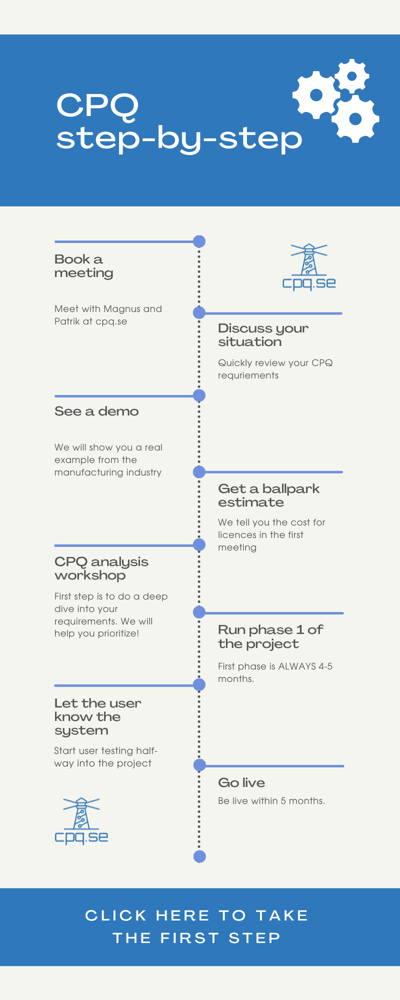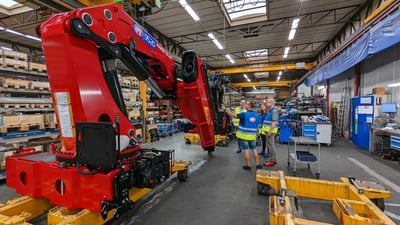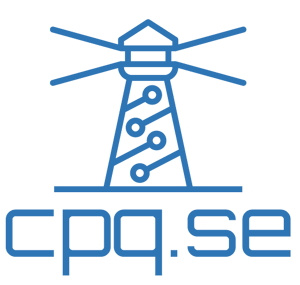Introduction to CPQ
With so many products and options available, it's essential for sales teams to be able to quickly and accurately configure and price products for their customers. This is where CPQ (Configure, Price, Quote) comes in.
 CPQ is a software solution that streamlines the sales process by automating the configuration, pricing, and quoting of products. It allows sales teams to quickly and easily create accurate quotes for their customers, without the need for manual calculations or errors.
CPQ is a software solution that streamlines the sales process by automating the configuration, pricing, and quoting of products. It allows sales teams to quickly and easily create accurate quotes for their customers, without the need for manual calculations or errors.
But CPQ is not just about saving time and reducing errors. It also plays a crucial role in improving the customer experience. By providing customers with accurate, real-time pricing, CPQ helps to build trust and confidence in the sales process. It also allows customers to easily customize products to meet their specific needs, which can lead to increased sales and customer loyalty.
CPQ is especially beneficial for companies that sell complex, customizable products. It can be used to configure and price products in a variety of industries, including manufacturing, technology, and services.
CPQ is not just for large enterprises. Small and mid-sized businesses can also benefit from this technology, as it allows them to compete with larger companies by streamlining their sales process and improving their customer experience.
In this article you'll learn how to integrate CPQ with other systems, such as CRM and ERP, to create a seamless and efficient sales process. We'll also look at case studies of successful CPQ implementations to give you a better understanding of how this technology can be used in the real world.
Throughout this article, I'll be sharing my own personal experience and insights on how CPQ can be used to improve the sales process. I've spent many years working in the sales industry, and I've seen firsthand the positive impact that CPQ can have on a business.
CPQ overview
A CPQ system is made up of several key components that work together to automate the sales process. These components include product configuration, pricing, and quoting.
Product Configuration: This component allows sales teams to quickly and easily configure products to meet the specific needs of their customers. It includes features such as product selection, options, and add-ons. It also allows for the creation of custom products and pricing.
Pricing: This component of a CPQ system allows for the automated calculation of prices based on the products and options selected. It includes features such as price lists, discounts, and special pricing rules. It also allows for the creation of custom pricing.
Quoting: This component of a CPQ system allows for the creation of accurate, professional quotes for customers. It includes features such as quote templates, approvals, and e-signatures. It also allows for the integration of quotes with other systems, such as CRM and ERP.
In addition to these core components, a CPQ system may also include other features such as additional document generation, order management, and analytics.
One of the key benefits of a CPQ system is its ability to integrate with other systems, such as CRM and ERP, to create a seamless and efficient sales process. This allows for the automatic flow of information between systems, reducing the need for manual data entry and increasing accuracy.
Another key benefit of a CPQ system is its ability to automate the sales process, reducing the need for manual calculations and errors. This not only saves time, but also improves the customer experience by providing them with accurate, real-time pricing.
Configuration
One of the most important aspects of a CPQ system is the ability to configure products to meet the specific needs of customers. This includes the selection of options, add-ons, and customizations. This is normally the tricky part of the CPQ project and the most time consuming activity in a project.
 When configuring products, it's important to ensure that all options and add-ons are valid and compatible with each other. This can be achieved by using pre-defined rules and constraints within the CPQ system.
When configuring products, it's important to ensure that all options and add-ons are valid and compatible with each other. This can be achieved by using pre-defined rules and constraints within the CPQ system.
Another important aspect of product configuration is the ability to easily update and maintain product information. This includes the ability to add new products, options, and pricing as well as making changes to existing products.
Once products are configured, the CPQ system can then be used to create accurate quotes for customers. This includes the ability to generate professional-looking quotes using pre-defined templates and the ability to add approvals and e-signatures.
Another key feature of the quoting component of a CPQ system is the ability to integrate with other systems such as CRM and ERP. This allows for the automatic flow of information between systems, reducing the need for manual data entry and increasing accuracy.
Creating accurate quotes is essential for building trust and confidence in the sales process. By providing customers with real-time pricing, they can easily see the value of the products and services being offered.
It's also important to note that CPQ can help to reduce errors and save time by automating the quoting process. This can free up sales teams to focus on other important tasks such as customer engagement and relationship building.
Pricing
 One of the key benefits of a CPQ system is the ability to automate the pricing process by using pre-defined pricing rules. These rules can include things like discounts, special pricing, and volume-based pricing.
One of the key benefits of a CPQ system is the ability to automate the pricing process by using pre-defined pricing rules. These rules can include things like discounts, special pricing, and volume-based pricing.
It's important to have a clear and well-defined pricing strategy in place to ensure that the pricing rules in the CPQ system are aligned with the overall business goals. This strategy should take into account factors such as cost of goods sold, competition, and target market.
The pricing rules within a CPQ system can also be configured to take into account other factors such as customer type, product type, and even the time of day. This allows for the creation of highly customized and targeted pricing.
The CPQ system should also have the capability to easily update and maintain pricing rules as needed. This includes the ability to add new pricing rules and make changes to existing ones.
It's also important to regularly review and analyze the pricing rules within the CPQ system to ensure that they are still aligned with the overall business goals. This can be done using analytics and reporting capabilities within the system.
Managing and maintaining pricing rules within a CPQ system can also help to improve the customer experience by providing them with transparent and accurate pricing. It also helps to build trust and confidence in the sales process.
Integrations
A CPQ system is only as effective as its ability to integrate with other systems that are already in place within an organization. One of the most important systems to integrate with is a CRM (Customer Relationship Management) system.
 Integrating a CPQ system with a CRM system allows for the automatic flow of customer information between the two systems. This includes information such as contact details, account history, and sales pipeline.
Integrating a CPQ system with a CRM system allows for the automatic flow of customer information between the two systems. This includes information such as contact details, account history, and sales pipeline.
This integration allows sales teams to have a complete view of the customer, including their purchasing history and current opportunities. This can help to improve the customer experience by providing more personalized and targeted sales interactions.
Another important system to integrate with is an ERP (Enterprise Resource Planning) system. This integration allows for the automatic flow of product and inventory information between the two systems.
This integration ensures that product and inventory information is always up-to-date and accurate. It also allows for the automation of the ordering and fulfillment process, reducing the need for manual data entry and increasing accuracy.
Other systems that a CPQ system can be integrated with include e-commerce platforms, marketing automation systems, and accounting systems.
Best practice
Implementing a CPQ system is a great step towards streamlining the sales process and improving the customer experience, but it's important to use it effectively in order to see the best results. Here are a few best practices to keep in mind:
Ensure that the CPQ system is properly configured and that all product and pricing information is up-to-date and accurate.
 Use constraints to ensure that products are configured correctly and that pricing is accurate.
Use constraints to ensure that products are configured correctly and that pricing is accurate.
Use analytics and reporting capabilities within the CPQ system to regularly review and analyze pricing rules and product configurations to ensure they are aligned with overall business goals.
Use the CPQ system to improve the customer experience by providing them with accurate and real-time pricing, and by allowing them to easily customize products and iterate to meet their specific needs.
Integrate the CPQ system with other systems, such as CRM and ERP, to create a seamless and efficient sales process.
Regularly train your sales team on how to use the CPQ system to ensure they are able to fully utilize its capabilities.
Continuously monitor and measure the performance of the CPQ system to identify areas for improvement and make adjustments as necessary.
By following these best practices, you can ensure that your CPQ system is being used to its fullest potential and that it's helping to improve both sales efficiency and the customer experience.
Case studies
One of the best ways to understand the capabilities and potential of a CPQ system is to look at real-world examples of how it has been implemented and used by other organizations.
These case studies demonstrate the potential of CPQ to improve the sales process, increase sales, and improve customer satisfaction. They also show the potential of CPQ to be used in different industries and for different types of products and services.
Conclusion
Throughout this article, we've examined the different components of a CPQ system, how it can be used to improve the sales process, and how it can be integrated with other systems to create a seamless and efficient sales process.
It's clear that CPQ technology has the potential to significantly improve the sales process, increase sales, and improve customer satisfaction. It's also a technology that can be used in different industries and for different types of products and services.
As the business world becomes more competitive and customers demand more personalized and efficient experiences, it's expected that the adoption of CPQ technology will continue to grow.
The future outlook for CPQ technology is very promising, with advancements in areas such as artificial intelligence and machine learning expected to further improve the capabilities of the system. This will allow for even more advanced and personalized product configurations and pricing.
CPQ technology is an essential tool for any organization looking to streamline the sales process, increase sales, and improve customer satisfaction. It's a technology that will continue to evolve and improve in the coming years, and one that many more organizations should consider implementing.
At cpq.se, we specialize in helping European small- and midsized manufacturers take their business to the next level with the use of cutting-edge tools for configuration, pricing, and quoting. With over two decades of experience in the field, our team is well-equipped to guide you through the process of implementing your own CPQ solution.
One of the key advantages of working with cpq.se is our ability to help you select the best CPQ system for your needs, with Tacton CPQ being one of the most popular options among our clients. We then work closely with you to define your project, prioritize getting you live as soon as possible, provide proper training in configuration, pricing and quoting and run the project in collaboration. We are committed to getting you up and running in just 4-5 months, and we'll continue to support you for years to come. Trust cpq.se to help you streamline your operations and take your business to the next level.
Find a time below and we'll give you an proper introductio; including prices, demo of an actual implementation and on top of that answers to all your CPQ questions.

